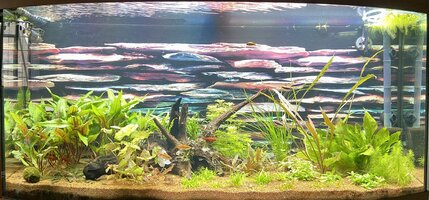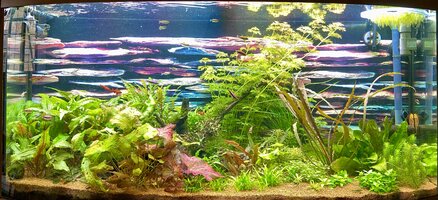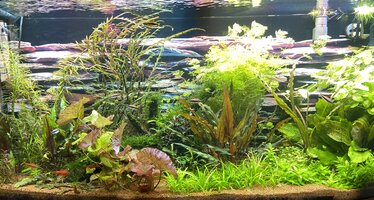hypnogogia
Member
After much deliberation I've decided to write a journal. Unlike many, I'm not starting at the beginning, but 5 years into the life of this aquarium.

Oase Biomater thermo 600 filter
Maxspect Gyre XF330, runs during the day only. Switched off at night for shrimp to clean off.
Juwel Helialux lighting (original version), plus Interpret HO LED light
Photoperiod: 10:30 - 20:30
CO2, about 20ppm
Fertilisation DIY all in one, daily. EI.
Weekly 50-60% water change with rain water when available, otherwise RO.
8 Kuhi loaches
25 purple emperor Tetra
10 cherry barbs
4 laser Cory
1 Orange bristlenose
1 Otto (another survivor of the GDMP)
Cherry shrimp
5 Amanos
Nymphoides Taiwan
Limnophila sessiflora
Limnophila hippuridoides
H. Pinnatifada
Bucephalandra 'Kedagang'
Microsorum pteropus Trident
Hydrocotyle leucocephala
Bucephalandra Theia Green
Taxiphyllum Barbieri
Pogostemon Erectus
Hydrocotyle tripartita Japan
Staurogyne Repens
Cyperus helferi
Pogostemon Helferi
Echinodorus Ozelot Leopard Green
Cryptocoryne Spiralis Red
Tiger Lotus, Red and Green
Crypt "Rosen Maiden "Nurii"
Crypt Wendii Green
Crypt Undulatus red
Limnobium laevigatum
The first list of plants are all relatively new after my latest changes and have replaced 3 large E. Bleheri, and an E. Red Diamond. I decided to take out the Amazon Swords as the tank was pretty samy, same shades of green and a bit dull, and the Bleheri constantly had holes in it form the bristlenose. I now have variation and am loving that. It was also my first venture into epiphytes, which seem to be doing well.

The L. Sessiflora has grown well and needs a trim. However sitting in bed after some surgery, that job will need to wait. I did manage a water change before I went in, so that should be good until next weekend. The H. Pinnatifada is also developing nicely. it's beginning to pup up behind from the root behind the Tiger Lotus/. The L. hippuridoides is also beginning to grow, although more slowly than I had anticipated. Never mind slower growth = less trimming.
That's it, up to date. I'll add pics as it now develops and grows in. No doubt I'll have questions and always welcome advice.
Why 'The Living Aquarium'?
Two reasons: One of my favourite aquarium books is called 'The Living Aquarium'. It was given to me as a Christmas present as a child when I had a small, 60 cm tank. From it I gained inspiration to save up for a 120cm from my paper round and Saturday job. It's a great book that gave me ideas for fish and plants. Secondly, my aquarium has now been going for 5 years and has gone through many changes. Not only does it contain life forms, but it's alive and evolves with time. I think I'm now at a point where I'm truly beginning to be happy with with it. Here's a full tank shot from about 3 weeks ago.
Tank and Equipment
Juwel Vision 260Oase Biomater thermo 600 filter
Maxspect Gyre XF330, runs during the day only. Switched off at night for shrimp to clean off.
Juwel Helialux lighting (original version), plus Interpret HO LED light
Photoperiod: 10:30 - 20:30
CO2, about 20ppm
Fertilisation DIY all in one, daily. EI.
Weekly 50-60% water change with rain water when available, otherwise RO.
Critters
2 Clown loaches, have been in since the start and survived the' great daughter made purge' (GDMP) see later.8 Kuhi loaches
25 purple emperor Tetra
10 cherry barbs
4 laser Cory
1 Orange bristlenose
1 Otto (another survivor of the GDMP)
Cherry shrimp
5 Amanos
Plants
Sagittaria SubulataNymphoides Taiwan
Limnophila sessiflora
Limnophila hippuridoides
H. Pinnatifada
Bucephalandra 'Kedagang'
Microsorum pteropus Trident
Hydrocotyle leucocephala
Bucephalandra Theia Green
Taxiphyllum Barbieri
Pogostemon Erectus
Hydrocotyle tripartita Japan
Staurogyne Repens
Cyperus helferi
Pogostemon Helferi
Echinodorus Ozelot Leopard Green
Cryptocoryne Spiralis Red
Tiger Lotus, Red and Green
Crypt "Rosen Maiden "Nurii"
Crypt Wendii Green
Crypt Undulatus red
Limnobium laevigatum
The first list of plants are all relatively new after my latest changes and have replaced 3 large E. Bleheri, and an E. Red Diamond. I decided to take out the Amazon Swords as the tank was pretty samy, same shades of green and a bit dull, and the Bleheri constantly had holes in it form the bristlenose. I now have variation and am loving that. It was also my first venture into epiphytes, which seem to be doing well.
Original set up
The original set up came with two T5 bulbs and the Juwel internal bioflow filter. It was a. good filter but was ugly and took space. I also wanted more light, hence the change. I changed the lighting first, within about the first 5 months. The filter was changed about 3 years in.
The great daughter made purge
In March '21, my then 6 year old daughter decided to be helpful one weekend when I was away by feeding the fish. She tipped almost 2 tubs of food into the tank. By the time I came home the damage was done. Most of the fish wiped out, including my much loved Avatar Red Tailed Shark. The little cherry shrimp bodies - about 100 - were all over the place. It was very sad. All in ask I estimate that I lost 90% of my stock and many plants melted because of the ammonia. But, I started again. Near total water changes every day for about 2 weeks and slowly the tank started reviving, But it took a long time. Whilst there ed Tailed Black shark was my favourite, I do not miss him. He was too lively for the tank and the other inmates seem much happier and at peace now. I'm pleased that of my original fish stock, the clown loaches, some purple emperor tetras and 1 Oto survived. I was surprised to find hm about 4 weeks ago happily grazing away. I now see him regularly.Current
Ever since the purge, I had struggled to re-establoish a colony of cherry shrimp. This sparked the latest change, introducing a large piece of carbo wood with ephipytes and moss and thus creating more hiding places them. They seem to be doing well, but I have yet to see babies. I'm also paying much more attention to water conditions now. I make sure that Gh is about 6 and Kh is 1 and this seems to suit the cherries much better. My TDS is about 250. I'd like to bring the down, so that is the next focus for me. As of today, it looks like this:
The L. Sessiflora has grown well and needs a trim. However sitting in bed after some surgery, that job will need to wait. I did manage a water change before I went in, so that should be good until next weekend. The H. Pinnatifada is also developing nicely. it's beginning to pup up behind from the root behind the Tiger Lotus/. The L. hippuridoides is also beginning to grow, although more slowly than I had anticipated. Never mind slower growth = less trimming.
That's it, up to date. I'll add pics as it now develops and grows in. No doubt I'll have questions and always welcome advice.
What I’ve learnt (a non exhaustive list)
- Keep fish food away from little hands
- Water change, water change, water change
- High flow. I ran an aquarium back in 1996--2000. I had the overhead Tunze filtration system, CO2 and a Giesemann metal halide light (140W) on a 150L tank. It was the first time that plants grew properly for me. The term high tech didn't exist then, but that's what I was running. The flow from the filter was immense and that, together with good quality lighting and CO2 made for great plant growth. If EI existed, I hadn't come across it, so I just used a standard weekly fertiliser.
- Stability - keep the conditions stable, in all ways. Lighting, flow/flitration, CO2 and especially water parameters. I used to mix Welsh Tap water with rain and had excellent water. Where I live now the Tap TDS is 680, Kh of about 18. I now use exclusively rain or RO and remineralise it to 6Gh and 1Kh. In my experience the less a tank is interfered with, the better.
- Filtration - I used to think having fancy filter media was important to good filtration. I had no idea that plants are your best filters. So, I had coarse filter, carbon, fine filter, and fleece. At other times I used special chemical stuff to reduce what I thought was excessive phosphate and nitrate. It wasn't until joining here and reading that I learnt that all I needed was good flow through a media that will support the bacteria. the test is done by plants.
- Fertilisation doesn't cause algae. When I first started as a child, I had terrible algae and no plant growth. That's because I used water that came though a water softener (My poor fish
) and had the wrong light. . Then I had great plant growth with the Welsh Tap and rain tank with high light and flow, and little to no algae. The one real algae problem I had with the current set up was BBA, until I got the flow right.
- Ions are Ions - use dry salts to mix your own, your plants and fish don't care if it's a fancy big name manufacturer or not. You know what's going in and how much and you save £££. I now costs me about £10 a year. Using a not too expensive ready mixed AIO, would probably cost me about £100 per year.
- Don't use a bow front tank. I bought bow front as we were limited on space and I wanted higher volume and this fit the bill. It distorts the view. I'd also get a shallower tank next time.
- Water testing has its limits. I used to test regularly. I started using JBL strips, and when they told me that my nitrates were 40ppm I thought them too high. I fought a loosing battle to reduce them. My plants were doing really well, but I thought it would be bad for fish. I became suspicious when, after an 80% water change, I still have a reading of 40ppm. I then bought JBL liquids to test. I did a dip test and a liquid test. The dip test gave a reading of 40ppm and then liquid of 20ppm. At that point I gave up. All I test for now is Gh and Kh and TDS of my water change water.
Last edited:




